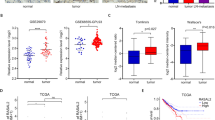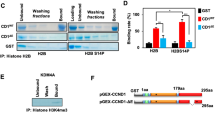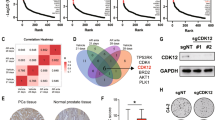Abstract
Prostate cancer (PCa) cell proliferation is dependent on activation of the androgen receptor (AR), a ligand-dependent transcription factor. AR activation controls G1–S phase progression through fostering enhanced translation of the D-type cyclins, which promote cell cycle progression through activation of CDK4/6. However, the D-type cyclins harbor additional, CDK4/6 kinase-independent, functions through manipulation of transcription factors, including AR. It was previously established that cyclins D1 and D3 have the potential to modulate AR, and with regard to cyclin D1, disruption of this function occurs in human tumors. Therefore, it was essential to interrogate cyclin D3 function in this tumor type. Here, we show that cyclin D3 is found in association with AR in PCa cells, as mediated through a conserved motif. Cyclin D3 functions to attenuate AR activity through defined mechanisms that include modulation of ligand-dependent conformational changes and modulation of chromatin binding activity. Accumulated cyclin D3 slows cell proliferation in AR-dependent cells, thus suggesting that androgen-induced D-type cyclin production serves to temper the mitogenic response to androgen. Supporting this hypothesis, it is shown that cyclin D3 expression is reduced in primary PCas as a function of tumor grade, and inversely correlates with the proliferative index. In total, these data identify cyclin D3 as a critical modulator of the androgen response, whose deregulation may foster unchecked AR activity in PCa.
This is a preview of subscription content, access via your institution
Access options
Subscribe to this journal
Receive 50 print issues and online access
$259.00 per year
only $5.18 per issue
Buy this article
- Purchase on SpringerLink
- Instant access to full article PDF
Prices may be subject to local taxes which are calculated during checkout






Similar content being viewed by others
References
Arap W, Nishikawa R, Furnari FB, Cavenee WK, Huang HJ . (1995). Replacement of the p16/CDKN2 gene suppresses human glioma cell growth. Cancer Res 55: 1351–1354.
Bienvenu F, Gascan H, Coqueret O . (2001). Cyclin D1 represses STAT3 activation through a Cdk4-independent mechanism. J Biol Chem 276: 16840–16847.
Braden WA, Lenihan JM, Lan Z, Luce KS, Zagorski W, Bosco E et al. (2006). Distinct action of the retinoblastoma pathway on the DNA replication machinery defines specific roles for cyclin-dependent kinase complexes in prereplication complex assembly and S-phase progression. Mol Cell Biol 26: 7667–7681.
Burd CJ, Petre CE, Moghadam H, Wilson EM, Knudsen KE . (2005). Cyclin D1 binding to the androgen receptor (AR) NH2-terminal domain inhibits activation function 2 association and reveals dual roles for AR corepression. Mol Endocrinol 19: 607–620.
Burd CJ, Petre CE, Morey LM, Wang Y, Revelo MP, Haiman CA et al. (2006). Cyclin D1b variant influences prostate cancer growth through aberrant androgen receptor regulation. Proc Natl Acad Sci USA 103: 2190–2195.
Chen C, Okayama H . (1987). High-efficiency transformation of mammalian cells by plasmid DNA. Mol Cell Biol 7: 2745–2752.
Cheng M, Sexl V, Sherr CJ, Roussel MF . (1998). Assembly of cyclin D-dependent kinase and titration of p27Kip1 regulated by mitogen-activated protein kinase kinase (MEK1). Proc Natl Acad Sci USA 95: 1091–1096.
Comstock CE, Revelo MP, Buncher CR, Knudsen KE . (2007). Impact of differential cyclin D1 expression and localisation in prostate cancer. Br J Cancer 96: 970–979.
Coqueret O . (2002). Linking cyclins to transcriptional control. Gene 299: 35–55.
Ewen ME, Lamb J . (2004). The activities of cyclin D1 that drive tumorigenesis. Trends Mol Med 10: 158–162.
Ewen ME, Sluss HK, Sherr CJ, Matsushime H, Kato J, Livingston DM . (1993). Functional interactions of the retinoblastoma protein with mammalian D-type cyclins. Cell 73: 487–497.
Fantl V, Stamp G, Andrews A, Rosewell I, Dickson C . (1995). Mice lacking cyclin D1 are small and show defects in eye and mammary gland development. Genes Dev 9: 2364–2372.
Fribourg AF, Knudsen KE, Strobeck MW, Lindhorst CM, Knudsen ES . (2000). Differential requirements for ras and the retinoblastoma tumor suppressor protein in the androgen dependence of prostatic adenocarcinoma cells. Cell Growth Differ 11: 361–372.
Fu M, Rao M, Bouras T, Wang C, Wu K, Zhang X et al. (2005). Cyclin D1 inhibits peroxisome proliferator-activated receptor gamma-mediated adipogenesis through histone deacetylase recruitment. J Biol Chem 280: 16934–16941.
Fu M, Wang C, Li Z, Sakamaki T, Pestell RG . (2004). Minireview: cyclin D1: normal and abnormal functions. Endocrinology 145: 5439–5447.
Ganter B, Fu S, Lipsick JS . (1998). D-type cyclins repress transcriptional activation by the v-Myb but not the c-Myb DNA-binding domain. EMBO J 17: 255–268.
He B, Kemppainen JA, Wilson EM . (2000). FXXLF and WXXLF sequences mediate the NH2-terminal interaction with the ligand binding domain of the androgen receptor. J Biol Chem 275: 22986–22994.
Hedberg Y, Roos G, Ljungberg B, Landberg G . (2002). Cyclin D3 protein content in human renal cell carcinoma in relation to cyclin D1 and clinico-pathological parameters. Acta Oncol 41: 175–181.
Huang HJ, Yee JK, Shew JY, Chen PL, Bookstein R, Friedmann T et al. (1988). Suppression of the neoplastic phenotype by replacement of the RB gene in human cancer cells. Science 242: 1563–1566.
Inoue K, Sherr CJ . (1998). Gene expression and cell cycle arrest mediated by transcription factor DMP1 is antagonized by D-type cyclins through a cyclin-dependent-kinase-independent mechanism. Mol Cell Biol 18: 1590–1600.
Jian Y, Yan J, Wang H, Chen C, Sun M, Jiang J et al. (2005). Cyclin D3 interacts with vitamin D receptor and regulates its transcription activity. Biochem Biophys Res Commun 335: 739–748.
Kaighn ME, Narayan KS, Ohnuki Y, Lechner JF, Jones LW . (1979). Establishment and characterization of a human prostatic carcinoma cell line (PC-3). Invest Urol 17: 16–23.
Kato A, Ota S, Bamba H, Wong RM, Ohmura E, Imai Y et al. (1998). Regulation of cyclin D-dependent kinase activity in rat liver regeneration. Biochem Biophys Res Commun 245: 70–74.
Kato JY, Sherr CJ . (1993). Inhibition of granulocyte differentiation by G1 cyclins D2 and D3 but not D1. Proc Natl Acad Sci USA 90: 11513–11517.
Kiess M, Gill RM, Hamel PA . (1995). Expression of the positive regulator of cell cycle progression, cyclin D3, is induced during differentiation of myoblasts into quiescent myotubes. Oncogene 10: 159–166.
Knudsen KE . (2006). The cyclin D1b splice variant: an old oncogene learns new tricks. Cell Div 1: 15.
Knudsen KE, Arden KC, Cavenee WK . (1998). Multiple G1 regulatory elements control the androgen-dependent proliferation of prostatic carcinoma cells. J Biol Chem 273: 20213–20222.
Knudsen KE, Cavenee WK, Arden KC . (1999). D-type cyclins complex with the androgen receptor and inhibit its transcriptional transactivation ability. Cancer Res 59: 2297–2301.
Knudsen KE, Diehl JA, Haiman CA, Knudsen ES . (2006). Cyclin D1: polymorphism, aberrant splicing and cancer risk. Oncogene 25: 1620–1628.
Lamb J, Ladha MH, McMahon C, Sutherland RL, Ewen ME . (2000). Regulation of the functional interaction between cyclin D1 and the estrogen receptor. Mol Cell Biol 20: 8667–8675.
Landis MW, Pawlyk BS, Li T, Sicinski P, Hinds PW . (2006). Cyclin D1-dependent kinase activity in murine development and mammary tumorigenesis. Cancer Cell 9: 13–22.
Li J, Zhang D, Fu J, Huang Z, Wong J . (2007). Structural and functional analysis of androgen receptor in chromatin. Mol Endocrinol.
Lim J, Ghadessy FJ, Abdullah AA, Pinsky L, Trifiro M, Yong EL . (2000). Human androgen receptor mutation disrupts ternary interactions between ligand, receptor domains, and the coactivator TIF2 (transcription intermediary factor 2). Mol Endocrinol 14: 1187–1197.
Lim JT, Mansukhani M, Weinstein IB . (2005). Cyclin-dependent kinase 6 associates with the androgen receptor and enhances its transcriptional activity in prostate cancer cells. Proc Natl Acad Sci USA 102: 5156–5161.
Lin HM, Zhao L, Cheng SY . (2002). Cyclin D1 is a ligand-independent co-repressor for thyroid hormone receptors. J Biol Chem 277: 28733–28741.
Link KA, Burd CJ, Williams E, Marshall T, Rosson G, Henry E et al. (2005). BAF57 governs androgen receptor action and androgen-dependent proliferation through SWI/SNF. Mol Cell Biol 25: 2200–2215.
Matsushime H, Ewen ME, Strom DK, Kato JY, Hanks SK, Roussel MF et al. (1992). Identification and properties of an atypical catalytic subunit (p34PSK-J3/cdk4) for mammalian D type G1 cyclins. Cell 71: 323–334.
McMahon C, Suthiphongchai T, DiRenzo J, Ewen ME . (1999). P/CAF associates with cyclin D1 and potentiates its activation of the estrogen receptor. Proc Natl Acad Sci USA 96: 5382–5387.
Miehlke S, Yu J, Ebert M, Szokodi D, Vieth M, Kuhlisch E et al. (2002). Expression of G1 phase cyclins in human gastric cancer and gastric mucosa of first-degree relatives. Dig Dis Sci 47: 1248–1256.
Miller GJ, Stapleton GE, Hedlund TE, Moffat KA . (1995). Vitamin D receptor expression, 24-hydroxylase activity, and inhibition of growth by 1alpha,25-dihydroxyvitamin D3 in seven human prostatic carcinoma cell lines. Clin Cancer Res 1: 997–1003.
Mittnacht S . (1998). Control of pRB phosphorylation. Curr Opin Genet Dev 8: 21–27.
Neuman E, Ladha MH, Lin N, Upton TM, Miller SJ, DiRenzo J et al. (1997). Cyclin D1 stimulation of estrogen receptor transcriptional activity independent of cdk4. Mol Cell Biol 17: 5338–5347.
Parry D, Mahony D, Wills K, Lees E . (1999). Cyclin D–CDK subunit arrangement is dependent on the availability of competing INK4 and p21 class inhibitors. Mol Cell Biol 19: 1775–1783.
Perry JE, Grossmann ME, Tindall DJ . (1998). Epidermal growth factor induces cyclin D1 in a human prostate cancer cell line. Prostate 35: 117–124.
Peterson LF, Boyapati A, Ranganathan V, Iwama A, Tenen DG, Tsai S et al. (2005). The hematopoietic transcription factor AML1 (RUNX1) is negatively regulated by the cell cycle protein cyclin D3. Mol Cell Biol 25: 10205–10219.
Petre-Draviam CE, Cook SL, Burd CJ, Marshall TW, Wetherill YB, Knudsen KE . (2003). Specificity of cyclin D1 for androgen receptor regulation. Cancer Res 63: 4903–4913.
Petre-Draviam CE, Williams EB, Burd CJ, Gladden A, Moghadam H, Meller J et al. (2005). A central domain of cyclin D1 mediates nuclear receptor corepressor activity. Oncogene 24: 431–444.
Petre CE, Wetherill YB, Danielsen M, Knudsen KE . (2002). Cyclin D1: mechanism and consequence of androgen receptor co-repressor activity. J Biol Chem 277: 2207–2215.
Quelle DE, Ashmun RA, Shurtleff SA, Kato JY, Bar-Sagi D, Roussel MF et al. (1993). Overexpression of mouse D-type cyclins accelerates G1 phase in rodent fibroblasts. Genes Dev 7: 1559–1571.
Rao SS, Kohtz DS . (1995). Positive and negative regulation of D-type cyclin expression in skeletal myoblasts by basic fibroblast growth factor and transforming growth factor beta. A role for cyclin D1 in control of myoblast differentiation. J Biol Chem 270: 4093–4100.
Reutens AT, Fu M, Wang C, Albanese C, McPhaul MJ, Sun Z et al. (2001). Cyclin D1 binds the androgen receptor and regulates hormone-dependent signaling in a p300/CBP-associated factor (P/CAF)-dependent manner. Mol Endocrinol 15: 797–811.
Rundlett SE, Wu XP, Miesfeld RL . (1990). Functional characterizations of the androgen receptor confirm that the molecular basis of androgen action is transcriptional regulation. Mol Endocrinol 4: 708–714.
Sarruf DA, Iankova I, Abella A, Assou S, Miard S, Fajas L . (2005). Cyclin D3 promotes adipogenesis through activation of peroxisome proliferator-activated receptor gamma. Mol Cell Biol 25: 9985–9995.
Schwartz GG, Oeler TA, Uskokovic MR, Bahnson RR . (1994). Human prostate cancer cells: inhibition of proliferation by vitamin D analogs. Anticancer Res 14: 1077–1081.
Serrano M, Hannon GJ, Beach D . (1993). A new regulatory motif in cell-cycle control causing specific inhibition of cyclin D/CDK4. Nature 366: 704–707.
Sherr CJ, Roberts MJ . (1995). Inhibitors of mammalian G1 cyclin-dependent kinases. Genes Dev 9: 1149–1163.
Sicinska E, Aifantis I, Le Cam L, Swat W, Borowski C, Yu Q et al. (2003). Requirement for cyclin D3 in lymphocyte development and T cell leukemias. Cancer Cell 4: 451–461.
Sicinski P, Donaher JL, Parker SB, Li T, Fazeli A, Gardner H et al. (1995). Cyclin D1 provides a link between development and oncogenesis in the retina and breast. Cell 82: 621–630.
Skapek SX, Rhee J, Spicer DB, Lassar AB . (1995). Inhibition of myogenic differentiation in proliferating myoblasts by cyclin D1-dependent kinase. Science 267: 1022–1024.
Skowronski RJ, Peehl DM, Feldman D . (1993). Vitamin D and prostate cancer: 1,25 dihydroxyvitamin D3 receptors and actions in human prostate cancer cell lines. Endocrinology 132: 1952–1960.
Timchenko LT, Salisbury E, Wang GL, Nguyen H, Albrecht JH, Hershey JW et al. (2006). Age-specific CUGBP1–eIF2 complex increases translation of CCAAT/enhancer-binding protein beta in old liver. J Biol Chem 281: 32806–32819.
Wang C, Pattabiraman N, Zhou JN, Fu M, Sakamaki T, Albanese C et al. (2003). Cyclin D1 repression of peroxisome proliferator-activated receptor gamma expression and transactivation. Mol Cell Biol 23: 6159–6173.
Wang GL, Shi X, Salisbury E, Sun Y, Albrecht JH, Smith RG et al. (2006). Cyclin D3 maintains growth-inhibitory activity of C/EBPalpha by stabilizing C/EBPalpha–cdk2 and C/EBPalpha–Brm complexes. Mol Cell Biol 26: 2570–2582.
Wang GL, Shi X, Salisbury E, Sun Y, Albrecht JH, Smith RG et al. (2007). Growth hormone corrects proliferation and transcription of phosphoenolpyruvate carboxykinase in livers of old mice via elimination of CCAAT/enhancer-binding protein alpha–Brm complex. J Biol Chem 282: 1468–1478.
Wetherill YB, Hess-Wilson JK, Comstock CE, Shah SA, Buncher CR, Sallans L et al. (2006). Bisphenol A facilitates bypass of androgen ablation therapy in prostate cancer. Mol Cancer Ther 5: 3181–3190.
Xu Y, Chen SY, Ross KN, Balk SP . (2006). Androgens induce prostate cancer cell proliferation through mammalian target of rapamycin activation and post-transcriptional increases in cyclin D proteins. Cancer Res 66: 7783–7792.
Zhuang SH, Schwartz GG, Cameron D, Burnstein KL . (1997). Vitamin D receptor content and transcriptional activity do not fully predict antiproliferative effects of vitamin D in human prostate cancer cell lines. Mol Cell Endocrinol 126: 83–90.
Zong H, Chi Y, Wang Y, Yang Y, Zhang L, Chen H et al. (2007). Cyclin D3/CDK11p58 complex is involved in the repression of androgen receptor. Mol Cell Biol 27: 7125–7142.
Zwijsen RM, Buckle RS, Hijmans EM, Loomans CJ, Bernards R . (1998). Ligand-independent recruitment of steroid receptor coactivators to estrogen receptor by cyclin D1. Genes Dev 12: 3488–3498.
Acknowledgements
We thank both K Knudsen and E Knudsen laboratories for their technical and intellectual input and Sandy Schwemberger and George Babcock for flow cytometry assistance. This work was supported by CA099996 and CA116777 (to KEK). NAO and CJB were supported by NIEHS Training Grant T32-ES07250. CESC and LMM were supported by T32-CA117846.
Author information
Authors and Affiliations
Corresponding author
Additional information
Supplementary Information accompanies the paper on the Oncogene website (http://www.nature.com/onc).
Rights and permissions
About this article
Cite this article
Olshavsky, N., Groh, E., Comstock, C. et al. Cyclin D3 action in androgen receptor regulation and prostate cancer. Oncogene 27, 3111–3121 (2008). https://doi.org/10.1038/sj.onc.1210981
Received:
Revised:
Accepted:
Published:
Issue date:
DOI: https://doi.org/10.1038/sj.onc.1210981
Keywords
This article is cited by
-
CCND3 is indispensable for the maintenance of B-cell acute lymphoblastic leukemia
Oncogenesis (2022)
-
Prognostic significance of cyclin D3 expression in malignancy patients: a meta-analysis
Cancer Cell International (2019)
-
The role of sLZIP in cyclin D3-mediated negative regulation of androgen receptor transactivation and its involvement in prostate cancer
Oncogene (2015)
-
Caspase-2: the reinvented enzyme
Oncogene (2015)
-
Requirement for cyclin D3 in germinal center formation and function
Cell Research (2010)



